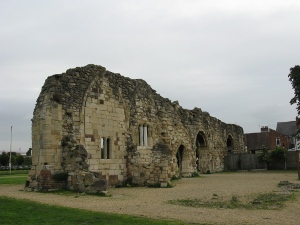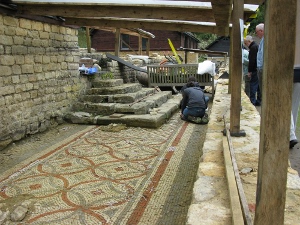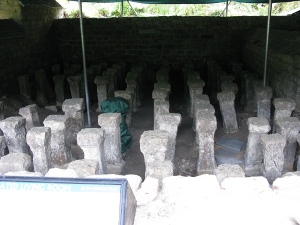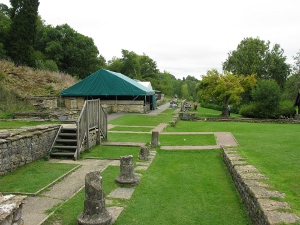 Ruins of St. Oswald's Abbey
Ruins of St. Oswald's Abbey
While we were preparing for our meeting with our friends, we took our laundry out, picking it up later in the afternoon all packed in a huge, fairly sturdy, zippered, attractive bag. We think it will make a distinctive tote bag. After making the rest of our hotel reservations we returned to our hotel for lunch.
 Ruins of St. Oswald's Abbey
Ruins of St. Oswald's Abbey
Marjorie and Patrick found us at the hotel in mid afternoon, and were quite properly impressed with the New Inn and its passageways (it's said to be haunted).
Walking through Gloucester we were able to show them one of the oldest ruins, St. Oswald's Anglo-Saxon Minster and Medieval Priory. Between the Roman occupation and the Norman Conquest, both pagan and Christian Anglo-Saxons lived in this area, and one Saxon king and queen built a church and a fortified wall here (they were later buried in the church).
However, the much better-known site in Gloucester is the cathedral with its intricate "perpendicular" architecture and beautifully lacy towers. We read Alison Weir's biography of Queen Isabella and King Edward II, so it was exactly appropriate to find his tomb here in the cathedral.
Our appreciation of the cathedral architecture and history was interrupted by the presence of numerous pieces of sculpture, paintings and textile  Gloucester Cathedral
art, both inside the cathedral and on the surrounding lawns. There was no particular religious theme to the art show, so we decided the cathedral had been chosen as a relatively secure location for the display.
Gloucester Cathedral
art, both inside the cathedral and on the surrounding lawns. There was no particular religious theme to the art show, so we decided the cathedral had been chosen as a relatively secure location for the display.
As we walked through the cloisters, we could hear the cathedral choir rehearsing -- glorious music. We had hoped to hear the choir at evensong, but there was too much else to do.
The following morning we met at their hotel just outside of town. Marjorie had done lots of research and had found a National Trust site, an excavation of a Roman villa in the Cotswolds near Gloucester. We followed little winding roads up hill and down dale, each one narrower and more picturesque than the last, till we got to Chedworth. We were glad Patrick was driving.
The excavation is well under way. The villa dates from the 4th century AD, and was probably one of the grandest country houses in Roman Britain. There were many spacious rooms, and several beautifully tiled baths. Archeologists were carefully at work stabilizing the remaining tiles, in a variety of  Archaeologists stabilizing
mosaic patterns. The Romans invented central heating in the form of a hypocaust, a low cellar with numerous pillars to support the floors above. Hot air from fires flowed into the hypocaust and out through flues set in the walls, warming the house.
Archaeologists stabilizing
mosaic patterns. The Romans invented central heating in the form of a hypocaust, a low cellar with numerous pillars to support the floors above. Hot air from fires flowed into the hypocaust and out through flues set in the walls, warming the house.
There were many other Roman settlements in this part of England, but by 400 AD, the glory days of Roman Britain were over. The empire was crumbling and there was no reason to continue to occupy far-flung properties like Chedworth. As the Romans abandoned Britain, the ability to maintain their culture was lost, and Roman buildings slowly fell into disrepair.
In 1864 a group of Victorian gentlemen were either hunting rabbits or poaching (it depends on the families telling the story) and found the remains of this villa. They were intrigued and began digging, discovering parts of the floor. Sightseers and helpers swarmed the scene. Fortunately some of the earliest amateur archaeologists made efforts to protect the villa with tents and by capping the stone walls so they would not fall down. Later, the  A hypocaust
landowner used the villa area for parties, building a museum and hunting lodge there. He also fought in Parliament to prevent the new railway line from crossing the Chedworth grounds. The National Trust bought the property in 1924 and little by little it has been studied, excavated, protected, and conserved.
A hypocaust
landowner used the villa area for parties, building a museum and hunting lodge there. He also fought in Parliament to prevent the new railway line from crossing the Chedworth grounds. The National Trust bought the property in 1924 and little by little it has been studied, excavated, protected, and conserved.
We explored several of the rooms of the villa, which was laid out in a rectangular shape with a central lawn. Visitors could get a closeup view of the rooms and baths (hot, warm, and cold), the tile work, and speak to the scientists. We talked about local wildlife and Roman herbs with the naturalist, who was preparing to instruct a school class. The villa was so large that not all of the building site has yet been acquired by The National Trust.
For lunch, we decided to visit the popular Cotswold village of Bourton-on-the-Water. We should have been warned when we found the car park half- The villa was huge
filled with tour buses, but we soldiered on into town where we were inundated by clumps of tourists. We found excellent sandwiches at the local bakery and enjoyed lunch at the edge of the stream which flows throught the center of the village.
The villa was huge
filled with tour buses, but we soldiered on into town where we were inundated by clumps of tourists. We found excellent sandwiches at the local bakery and enjoyed lunch at the edge of the stream which flows throught the center of the village.
Gloucester pretty much shuts down around five or six o'clock, but the Tiger's Eye, an Asian Fusion restaurant, welcomed us on our return to town. Located on the second floor above a row of shops, it's inconspicuous but worth hunting. They specialize in a Black Rock Grill, a ceramic stone heated to 440 degrees Centigrade. Diners cook their meat and vegetables (very quickly!) on the hot grill. We had posset, a dessert made of cream and sugar and a little lemon juice, that dates back to Elizabethan times, but was quite new to us. It's delicious, and we've managed to produce it at home in California.
For us, the visit with Marjorie and Patrick was one of the high spots of our entire vacation -- new, good friends with similar interests and lively curiosity. We met them through our genealogy studies - they are related to our daughter-in-law Donna. We now have several examples where part of a family emigrated to America and part stayed at home, leading to modern relatives on both sides of the Atlantic.